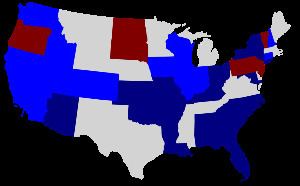November 8, 1932
(And other dates for special elections) 1934 → 27 5 11 11 | 47 48 58 36 16 16 | |
 | ||
Winner Joseph Taylor Ro | ||
The United States Senate elections of 1932 (and subsequent special elections in 1933) coincided with Democrat Franklin Delano Roosevelt's crushing defeat of incumbent Herbert Hoover in the presidential election. With the administration widely blamed for the Great Depression, Republicans lost twelve seats and control of the chamber. This became the first time since 1920 that the victorious party defended all of their own seats and achieved a pickup in the double-digits.
Contents
- Gains and losses
- Before the elections
- Complete list of races
- Elections during the 72nd Congress
- Elections leading to the 73rd Congress
- Election during the 73rd Congress
- References
This was the first election in history that a Senate leader (in this case the Majority Leader) from either party lost re-election.
Gains and losses
Democrats took open seats in California, Iowa, and Wisconsin, and defeated eight incumbents:
Democrat George McGill won re-election in Kansas. As of 2014, he is the last Democrat to win a U.S. Senate election in Kansas.
Hattie Caraway (D-AR) was the first woman to be elected to a full term in the Senate.
Before the elections
At the beginning of February 1932.
Complete list of races
All races are general elections for class 3 seats, unless noted.
Elections during the 72nd Congress
In these elections, the winners were seated during 1932 or in 1933 before March 4; ordered by election date.
Elections leading to the 73rd Congress
All elections are for Class 3 seats.
Election during the 73rd Congress
In this special election, the winner was elected in 1933 after March 4.
